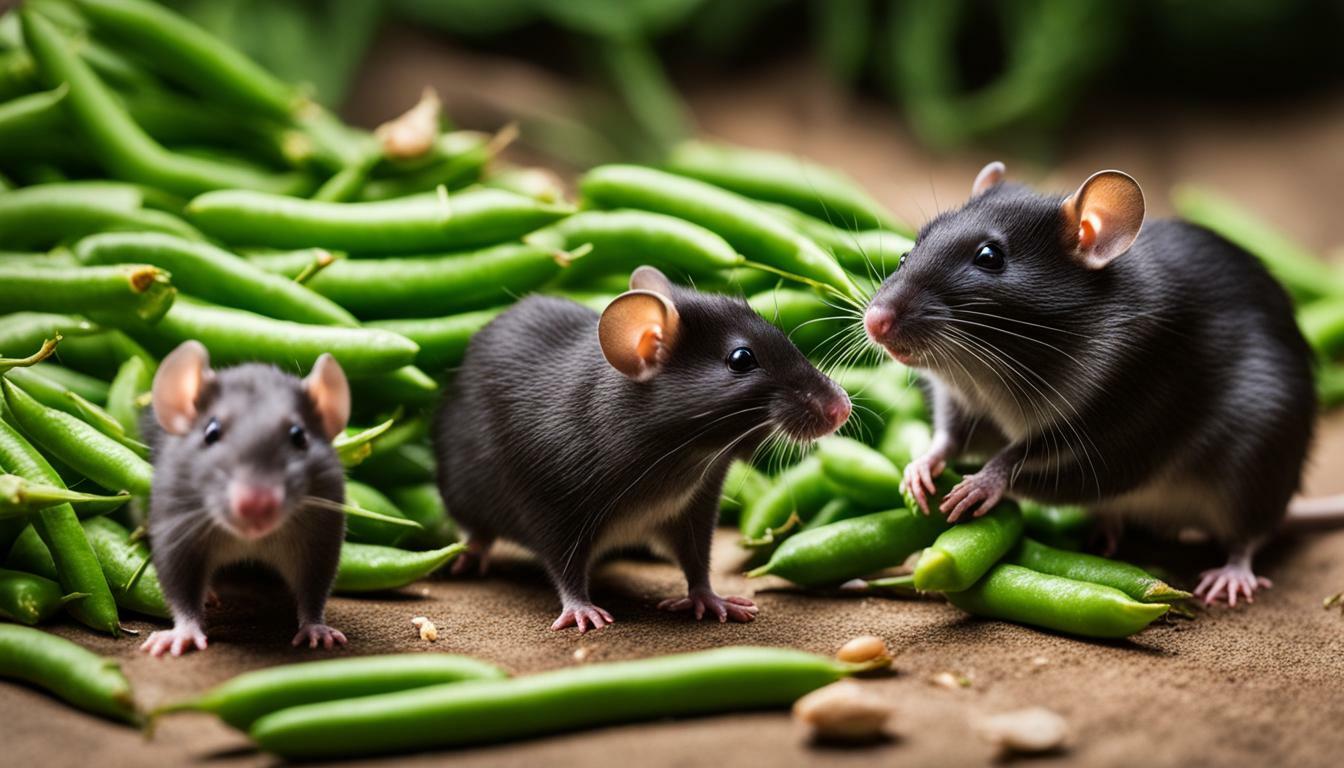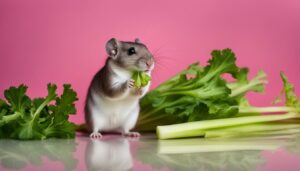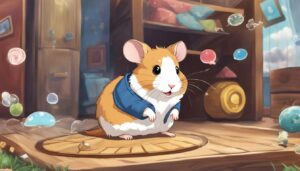If you’re wondering whether it’s safe to include green beans in your pet rat’s diet, you’ve come to the right place.
Rats can safely eat green beans as part of a balanced diet. While there are some concerns about anti-nutrients in beans, green beans have lower levels compared to kidney beans. They are low in fat and calories, high in fiber, and contain vitamins A, B, and K, as well as minerals like iron, copper, calcium, and magnesium. It is recommended to feed green beans in moderation and introduce them slowly to avoid digestive issues. Green beans can be fed raw, cooked, or canned, but variety in the diet is important, so it’s best to include other vegetables and fruits as well.
Key Takeaways:
- Green beans are safe for rats to eat as part of a balanced diet.
- They are low in fat and calories, high in fiber, and contain vitamins A, B, and K, as well as minerals like iron, copper, calcium, and magnesium.
- Feed green beans in moderation and introduce them slowly to avoid digestive issues.
- Green beans can be fed raw, cooked, or canned, but variety in the diet is important.
- Include other vegetables and fruits in your rat’s diet for optimal nutrition.
Understanding the Nutritional Value of Green Beans for Rats
Green beans offer a range of nutritional benefits that can support your pet rat’s overall health and well-being. These crunchy vegetables are low in fat and calories, making them a great addition to your rat’s diet. They are also high in fiber, which promotes healthy digestion and can prevent constipation. Additionally, green beans are packed with essential vitamins and minerals that your rat needs to thrive.
One of the key nutrients found in green beans is vitamin A, which contributes to healthy eyesight and immune function. They are also a good source of vitamins B and K, important for energy production and blood clotting, respectively. In terms of minerals, green beans contain iron, copper, calcium, and magnesium, which are necessary for various bodily functions, including the formation of red blood cells and strong bones. All of these nutrients work together to maintain your rat’s overall health.
The Nutritional Value of Green Beans (per 100 grams)
| Nutrient | Amount |
|---|---|
| Calories | 31 |
| Protein | 1.8 grams |
| Fat | 0.2 grams |
| Carbohydrates | 7.1 grams |
| Fiber | 2.7 grams |
| Vitamin A | 403 IU |
| Vitamin B | 0.1 milligrams |
| Vitamin K | 14.4 micrograms |
| Iron | 1.3 milligrams |
| Copper | 0.1 milligrams |
| Calcium | 43 milligrams |
| Magnesium | 25 milligrams |
When introducing green beans to your rat’s diet, it’s important to do so gradually. Start with small amounts and observe how your rat reacts. Some rats may have a sensitive stomach, so it’s best to introduce new foods slowly to avoid any potential digestive issues. Green beans can be fed raw, cooked, or canned, depending on your rat’s preference. However, it’s crucial to remember that variety is key. While green beans are a nutritious addition to their diet, it’s important to offer a diverse range of vegetables and fruits to ensure optimal nutrition.
So, can rats eat green beans? Absolutely! Green beans provide a range of nutritional benefits that can support your pet rat’s overall health. Just remember to feed them in moderation and incorporate them as part of a well-balanced diet that includes other vegetables and fruits. If you have any concerns about your rat’s diet or specific dietary requirements, it’s always a good idea to consult with a veterinarian for personalized recommendations.
Anti-Nutrients in Green Beans: What Rat Owners Should Know
While green beans do have some anti-nutrients, the levels are relatively low compared to other types of beans, making them a suitable choice for your pet rat. Anti-nutrients are naturally occurring substances found in certain foods that can interfere with nutrient absorption and digestion. In the case of green beans, the most common anti-nutrient is phytic acid.
Phytic acid, also known as phytate, is found in the outer layer of seeds and grains. It binds to minerals like calcium, iron, and zinc, reducing their bioavailability. However, the levels of phytic acid in green beans are significantly lower compared to kidney beans, for example. This means that the potential negative effects are minimal when feeding green beans to your rat.
Table: Comparison of Anti-Nutrients in Different Types of Beans
| Bean Type | Phytic Acid (g/100g) | Tannins (g/100g) | Lectins (g/100g) |
|---|---|---|---|
| Green Beans | 0.05 | 0.02 | Negligible |
| Kidney Beans | 0.66 | 0.02 | 0.02 |
| Lima Beans | 0.27 | 0.02 | 0.13 |
| Black Beans | 0.51 | 0.01 | 0.04 |
It’s important to note that even though green beans have lower levels of anti-nutrients, it is still recommended to feed them in moderation. Incorporating a variety of rat-friendly foods in their diet will help ensure balanced nutrition and reduce the potential negative impacts of anti-nutrients. By offering a diverse range of vegetables, fruits, and proteins, you can provide your pet rat with a well-rounded and healthy diet.
Introducing Green Beans to Your Rat’s Diet
When introducing green beans to your rat’s diet, it’s best to start with small amounts and gradually increase the serving size to avoid any digestive disturbances. Rats may need some time to adjust to new foods, so patience is key. Green beans can be a healthy and nutritious addition to their diet, providing them with essential vitamins, minerals, and fiber.
To incorporate green beans into your rat’s meals, you can feed them raw, steamed, or even canned. However, it’s essential to avoid seasoning or adding any harmful substances that may be present in canned green beans. Opt for fresh or frozen green beans whenever possible, as they offer the highest nutritional value.
While green beans are generally safe for rats, it’s important to remember that they should be just one component of a varied diet. Rats thrive on a diverse range of foods, including other vegetables, fruits, and proteins. By rotating different food options, you can ensure that your rat receives a well-rounded and balanced diet.
| Nutritional Content of Green Beans for Rats (per 100g) | Amount |
|---|---|
| Calories | 31 kcal |
| Protein | 1.8g |
| Fat | 0.2g |
| Fiber | 2.7g |
| Vitamin A | 758 IU |
| Vitamin B | 0.1mg |
| Vitamin K | 15.8mcg |
| Iron | 0.4mg |
| Copper | 0.1mg |
| Calcium | 37mg |
| Magnesium | 25mg |
Remember, moderation is key when feeding green beans to rats. While they offer several health benefits, it’s important not to overdo it. It’s always a good idea to consult with a veterinarian who can provide specific dietary recommendations for your pet rat. With a balanced and varied diet, including green beans as a healthy snack, your rat can enjoy a nutritious and fulfilling mealtime.
Moderation is Key: How Much Green Beans Can Rats Eat?
While green beans can be included in your rat’s diet, it’s crucial to provide them in moderation as part of a well-rounded meal plan. These nutritious vegetables offer several health benefits for your furry friend, but it’s important to avoid overfeeding them. Green beans are low in fat and calories, making them a suitable addition to your rat’s diet. Their high fiber content aids in digestion, and they also contain essential vitamins and minerals like vitamins A, B, and K, as well as iron, copper, calcium, and magnesium.
To ensure your rat receives optimal nutrition, it’s recommended to offer a varied diet that includes a mix of vegetables, fruits, and proteins. While green beans can be a healthy addition, they should not be the sole component of your rat’s meal plan. It’s best to introduce green beans slowly to avoid any potential digestive issues. Start with small amounts and gradually increase the portion size, observing your rat’s reaction. Remember, variety is key to a well-balanced rat diet.
When feeding green beans to your rat, you have options to serve them raw, cooked, or canned. However, always ensure they are thoroughly washed, and avoid seasoning or adding any harmful substances. Monitor your rat’s overall health and consult a veterinarian if you notice any adverse reactions or concerns. By providing green beans in moderation and alongside other safe foods for rats, you can contribute to your pet’s overall well-being.
| Benefits of Green Beans for Rats: |
|---|
| 1. Low fat and calorie content |
| 2. High fiber content for digestion |
| 3. Rich in vitamins A, B, and K |
| 4. Contains important minerals like iron, copper, calcium, and magnesium |
Remember, a balanced diet is essential for your rat’s health. Incorporate a variety of rat-friendly vegetables, fruits, and proteins into their meals, including green beans as part of a well-rounded nutritional plan. By providing a diverse range of foods, you can ensure your rat receives all the necessary nutrients for a healthy and fulfilling life.
Other Rat-Friendly Vegetables and Fruits to Consider
In addition to green beans, there are several other vegetables and fruits that can provide essential nutrients and variety to your rat’s diet. Including a diverse range of foods in their meals ensures that your pet rat receives optimal nutrition. Here are some rat-friendly options to consider:
- Carrots: These crunchy veggies are packed with Vitamin A and provide a good source of fiber.
- Broccoli: Rich in vitamins C and K, as well as fiber, broccoli is a healthy addition to your rat’s diet.
- Peas: Peas are a good source of protein, fiber, and essential vitamins like A, B, and C.
- Apples: This juicy fruit provides hydration and contains vitamins A and C, as well as dietary fiber.
Remember to offer these vegetables and fruits in moderation, just like you would with green beans. A varied diet is key to ensuring your rat gets all the necessary nutrients. Additionally, it’s important to wash fresh produce thoroughly before feeding it to your rat to remove any potential pesticides or dirt.
| Vegetable/Fruit | Nutritional Benefits |
|---|---|
| Carrots | Vitamin A, fiber |
| Broccoli | Vitamins C and K, fiber |
| Peas | Protein, fiber, vitamins A, B, and C |
| Apples | Vitamins A and C, dietary fiber |
Keep in mind that while these vegetables and fruits can be a healthy addition to your rat’s diet, they should not replace other essential elements like proteins and fats. It’s essential to provide a balanced diet that includes a mix of vegetables, fruits, proteins, and carbohydrates to ensure your rat remains healthy and active.
Summary:
Offering a variety of vegetables and fruits to your pet rat’s diet is crucial for their overall health and well-being. Alongside green beans, you can include other rat-friendly options like carrots, broccoli, peas, and apples. These foods provide essential nutrients such as vitamins A, B, and C, as well as fiber, which helps promote digestion. Remember to introduce new foods gradually and monitor your rat’s reaction. By offering a balanced diet, you can ensure that your furry friend receives all the necessary nutrients for a happy and healthy life.
The Importance of a Balanced Rat Diet
A balanced diet is essential for your pet rat’s overall health, and green beans can play a part in providing the necessary nutrients. While there are some concerns about anti-nutrients in beans, green beans have lower levels compared to kidney beans, making them a safer option.
Green beans are a nutritious addition to your rat’s diet, as they are low in fat and calories but high in fiber. They also contain important vitamins like A, B, and K, as well as minerals such as iron, copper, calcium, and magnesium.
To ensure your rat gets the most out of their diet, it’s important to feed green beans in moderation. Introduce them slowly to avoid any digestive issues, starting with small amounts and gradually increasing portion sizes. It’s also crucial to offer a variety of vegetables and fruits alongside green beans for a well-rounded diet.
Incorporating Variety in the Rat’s Diet
When feeding green beans to your rat, remember that variety is key. While green beans are a healthy snack, they should not be the sole component of their diet. Including other rat-friendly vegetables and fruits will help provide a broader range of nutrients.
| Vegetables for Rats | Fruits for Rats |
|---|---|
| Carrots | Apples |
| Broccoli | Berries |
| Spinach | Grapes |
| Bell peppers | Bananas |
By rotating different vegetables, fruits, and proteins, you can ensure that your rat receives a balanced diet with all the necessary nutrients. Remember to consult with a veterinarian for specific dietary recommendations tailored to your rat’s needs.
Potential Risks and Precautions When Feeding Green Beans to Rats
While green beans are generally safe for rats, it’s important to take certain precautions and monitor your pet for any adverse reactions. Here are some potential risks and guidelines to keep in mind when feeding green beans to your furry friend.
- Wash thoroughly: Before feeding green beans to your rat, make sure to wash them thoroughly to remove any pesticides or dirt. This will help ensure the safety of the food and prevent any harm to your pet.
- Avoid seasoning: Green beans should be fed to rats without any added seasoning or harmful substances. Salt, spices, and other seasonings can be harmful to rats, so it’s best to serve green beans plain.
- Monitor for allergies: Like humans, rats can have allergies to certain foods. When introducing green beans to your rat’s diet, observe their behavior and health for any signs of allergies, such as itching, sneezing, or difficulty breathing. If you notice any adverse reactions, discontinue feeding green beans and consult a veterinarian.
Remember, green beans should be part of a balanced diet for rats, not the sole component. It’s essential to offer a variety of fresh foods, such as other vegetables and fruits, to ensure your rat receives all the necessary nutrients.
| Potential Risks | Precautions |
|---|---|
| Washing green beans thoroughly | Remove pesticides and dirt |
| Avoid seasoning | Feed green beans plain |
| Monitor for allergies | Watch for signs of adverse reactions |
Feeding green beans to rats is generally safe, but it’s important to remember that every rat is different. Always consult with a veterinarian for specific dietary recommendations and guidance on introducing new foods to your pet’s diet.
Variety is Key: Building a Healthy Rat Diet
To provide optimal nutrition for your pet rat, it’s crucial to incorporate a variety of foods into their diet, including green beans. These versatile vegetables offer a range of health benefits and can be a great addition to their meal plan. However, it’s important to remember that green beans should not be the sole component of their diet. Rats require a balanced mix of proteins, carbohydrates, fats, and a diverse range of fresh foods to thrive.
When it comes to vegetables, green beans are among the best choices for rats. They are low in fat and calories, making them an ideal snack or addition to their meals. Green beans are also high in fiber, which helps support healthy digestion in rats. Furthermore, they are packed with essential vitamins and minerals like vitamins A, B, and K, as well as iron, copper, calcium, and magnesium.
| Nutrient | Amount per 100g of Green Beans |
|---|---|
| Vitamin A | 690 IU |
| Vitamin B | 0.1 mg |
| Vitamin K | 14.4 mcg |
| Iron | 1.03 mg |
| Copper | 0.07 mg |
| Calcium | 37 mg |
| Magnesium | 25 mg |
When introducing green beans to your rat’s diet, it’s important to do so gradually. Start with small amounts and monitor their reaction. This allows their digestive system to adjust and helps prevent any potential digestive issues. Green beans can be fed raw, cooked, or canned, providing flexibility in how you offer them to your furry friend. However, remember that variety is key. Alongside green beans, include other rat-friendly vegetables and fruits to ensure a well-rounded diet.
By building a healthy rat diet that incorporates a variety of foods, including green beans, you can provide your pet rat with the necessary nutrients for a happy and thriving life. Remember, always consult with a veterinarian for specific dietary recommendations tailored to your rat’s individual needs.
Can Rats Eat Green Beans – Final Verdict
In conclusion, rats can safely consume green beans as part of a well-balanced diet that includes a variety of foods. Green beans are low in fat and calories, making them a healthy option for your pet rat. They are also rich in fiber, which aids in digestion, and contain essential vitamins and minerals like vitamins A, B, and K, iron, copper, calcium, and magnesium.
While there are concerns about anti-nutrients in beans, green beans have lower levels compared to other types of beans, such as kidney beans. It is important to feed green beans in moderation and introduce them slowly to your rat’s diet. This will help prevent any potential digestive issues that may arise from sudden changes in their food.
When feeding green beans to your rat, you can offer them raw, cooked, or canned. However, it is crucial to ensure that the green beans are thoroughly washed and free from any harmful substances. Variety is key in a rat’s diet, so it is recommended to include other vegetables and fruits alongside green beans.
Benefits of Green Beans for Rats:
- Low in fat and calories
- High in fiber, aiding digestion
- Rich in vitamins A, B, and K
- Contain essential minerals like iron, copper, calcium, and magnesium
Remember, while green beans can be a nutritious addition to your rat’s diet, they should not be the sole component. It is important to provide a balanced diet that includes a mix of proteins, carbohydrates, fats, and a variety of fresh foods. Consulting with a veterinarian can also help ensure that your rat’s specific dietary needs are met.
| Safe Foods for Rats: | Foods to Avoid: |
|---|---|
|
|
Offering a well-rounded diet with a variety of rat-friendly vegetables and fruits will contribute to the overall health and wellbeing of your pet rat. Including green beans in their meals can provide nutritional benefits, but remember to always feed them in moderation.
Conclusion
When it comes to feeding green beans to your pet rat, remember that moderation, variety, and a balanced diet are key to ensuring their overall health and well-being. Rats can safely enjoy green beans as part of their diet, as they are low in fat and calories, high in fiber, and packed with vitamins and minerals.
While there are concerns about anti-nutrients in beans, green beans have lower levels compared to other types of beans, such as kidney beans. It is important to introduce green beans slowly and in small amounts to your rat’s diet to avoid any potential digestive issues.
Green beans can be fed raw, cooked, or even canned, but it is essential to provide variety in their diet by including other vegetables and fruits. This will ensure that your rat receives a balanced nutritional intake and benefits from the different nutrients provided by a diverse range of foods.
Remember to consult with a veterinarian if you have any specific concerns about your rat’s diet or if you notice any adverse reactions after introducing green beans or any other new food. With proper care and attention to their dietary needs, your pet rat can enjoy the occasional green bean treat while maintaining a healthy and happy life.
FAQ
Can rats safely eat green beans?
Yes, rats can safely eat green beans. They are low in fat and calories, high in fiber, and contain vitamins A, B, and K, as well as minerals like iron, copper, calcium, and magnesium.
Are there any concerns about anti-nutrients in green beans?
While green beans do contain some anti-nutrients, their levels are lower compared to other types of beans. It is important to incorporate a variety of rat-friendly foods in their diet to ensure balanced nutrition.
How should I introduce green beans to my rat’s diet?
It is best to start with small amounts of green beans and gradually increase the portion size to avoid any potential digestive issues. Green beans can be fed raw, cooked, or canned, but variety in the diet is important.
How much green beans can rats eat?
Rats should eat green beans in moderation. While they are generally safe, they should be part of a varied diet that includes other vegetables and fruits. Consulting with a veterinarian can provide specific dietary recommendations.
What other vegetables and fruits are suitable for rats?
Some other rat-friendly vegetables and fruits include carrots, broccoli, spinach, apples, and bananas. Offering a diverse range of foods ensures optimal nutrition for pet rats.
What precautions should I take when feeding green beans to rats?
Wash fresh green beans thoroughly and avoid seasoning or adding harmful substances. Monitor your rat’s reaction to green beans and consult a veterinarian if any issues arise.
How can I build a healthy rat diet?
Building a healthy rat diet involves offering a mix of proteins, carbohydrates, fats, and a variety of fresh foods. Rotating different vegetables, fruits, and proteins in their meals is recommended, including green beans as part of the overall balanced diet.
Can rats eat green beans as their sole food?
No, green beans should not be the sole component of a rat’s diet. They should be part of a varied diet that includes other foods to ensure a balanced nutritional intake.
Can rats safely eat green beans as a healthy snack?
Yes, when fed in moderation and as part of a varied diet, green beans can be a healthy snack for rats.
Can rats eat green beans – Final verdict?
Yes, rats can safely eat green beans. They are a nutritious addition to their diet when fed in moderation and as part of a varied selection of foods.




